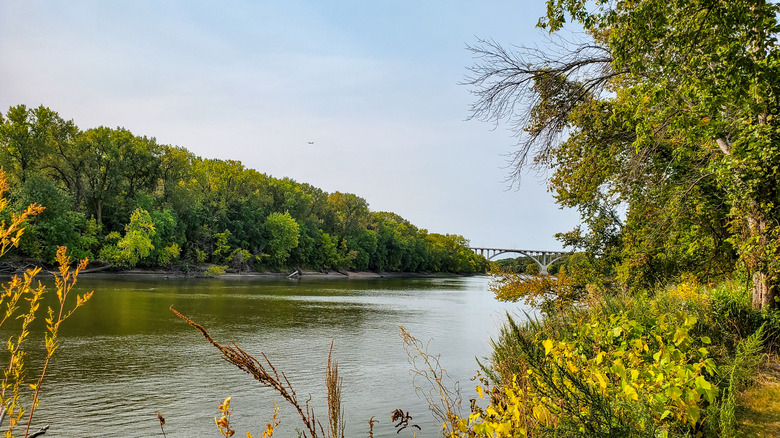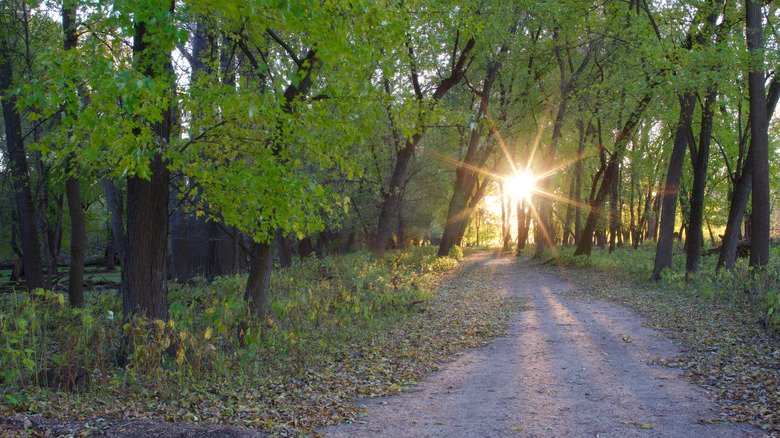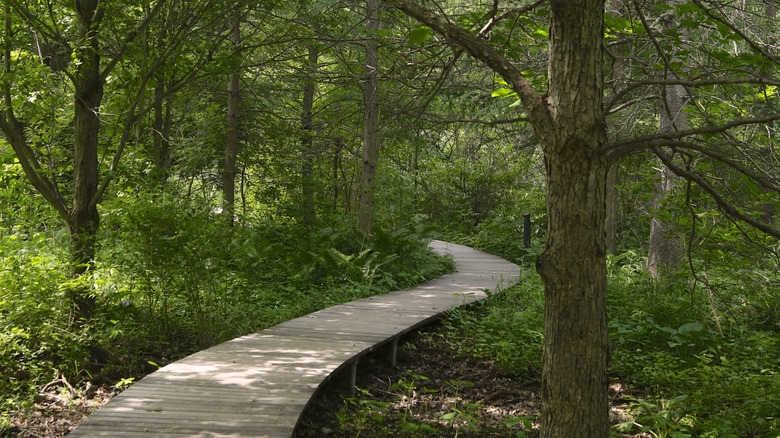Minnesota's 'Hidden Hiking Gem' Is A Serene River Island Outside St. Paul Full Of Natural Beauty
Urban hikes offer something that city dwellers desperately need — the chance to get out in nature and disconnect from all the trappings of the modern world. One of Minnesota's best city treks can be found on a tiny island only a 15-minute drive from Downtown St. Paul and less than 20 minutes from Downtown Minneapolis. In fact, this hidden hiking gem is so under the radar that many Minnesotans have never heard of it.
Set at the juncture of the Mississippi and Minnesota rivers, in Fort Snelling State Park, Pike Island is a peaceful getaway for Twin Cities folks seeking a taste of the outdoors. The island is small — less than 1.5 miles long and 0.25 miles wide — but offers a 3.9-mile hiking loop. And the best part? Only hikers and walkers are allowed, so you don't have to worry about bikes. Plus, there are plenty of benches, so pack a book and enjoy a serene afternoon.
Despite the island's small size, it occupies a significant place in Indigenous history. According to the native Dakota, the island is the birthplace of their people. Between the mid to late 1800s, Pike Island was also a cultural and commerce center where native people traded and made connections. This tiny bit of land is named after Zebulon Pike, the lieutenant who acquired the island on behalf of President Thomas Jefferson. Nowadays, Pike Island is an uncrowded escape that will soon climb to the top of your Twin Cities travel bucket list.
An overview of the Pike Island Loop
To access the Pike Island Loop, park in the lot at the Historic Fort Snelling Visitor Center ($6 per vehicle). Follow the signs until you reach the footbridge that crosses the Minnesota River. That's it — you made it to Pike Island. Regardless of whether you turn right or left, both directions offer serene river views and a flat, gravel trail shaded by cottonwoods, maples, and elms.
Pike Island is open year-round and is truly beautiful every month. During the summer, the island comes alive with lush foliage, and you can watch boats and kayaks in the rivers. The winter months bring a level of quiet that's hard to find in an urban environment. However, you can always hear cars crossing Mendota Bridge and noises from the airport. But, it's not a huge detracting point.
Pike Island is an ideal destination for travelers who want to exercise and get out in nature on a layover due to its location near Minneapolis–Saint Paul International Airport. Widely recognized as one of North America's best airports, MSP is only a 10-minute drive from the island. One reviewer on Tripadvisor commented, "I got up for an early morning hike before my flight, and found it really peaceful and beautiful with the icy river and dusting of snow. [It] was perfect before a long international flight to Singapore."
Other urban hiking spots near the Twin Cities
Often referred to as the City of Lakes, it's no wonder there are hundreds of miles of hiking trails around Minneapolis and St. Paul. Only a 15-minute drive from Downtown Minneapolis, the 5.4-mile-long Winchell Trail is the oldest hiking route in the area. Following the Mississippi River, this out-and-back trail goes under historic trestles, beneath oak canopies, and down stone steps. The route takes about two hours and allows dogs on leashes.
If you can't visit the underrated lakefront national parks, like Voyageurs, in the Midwest, spend an afternoon at Lake of the Isles. Situated 30 minutes from Downtown Minneapolis, this lake is one of the most popular green spaces in Minneapolis. It boasts a 2.7-mile trail that circles the lake. Welcoming cyclists, hikers, and walkers, the loop also connects to the paths at nearby Cedar Lake and Bde Maka Ska.
Completing the list, Theodore Wirth Regional Park is another urban hiking hot spot you can't miss. The 740-acre park is only a 10-minute drive from Minneapolis city center. The park boasts over 14 miles of trails, but the path through Eloise Butler Wildflower Garden & Bird Sanctuary is undoubtedly the most beautiful. Measuring a little over a mile, the trail winds through lush gardens displaying wetland, prairie, and woodland plants. Each biome has a different peak season, so check the garden's website before visiting.


